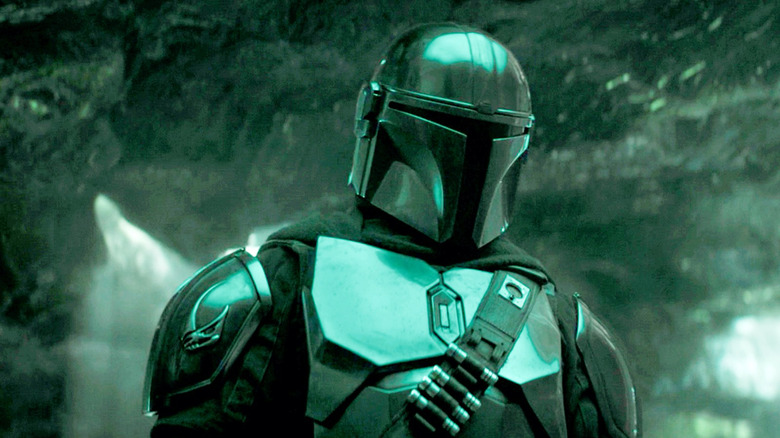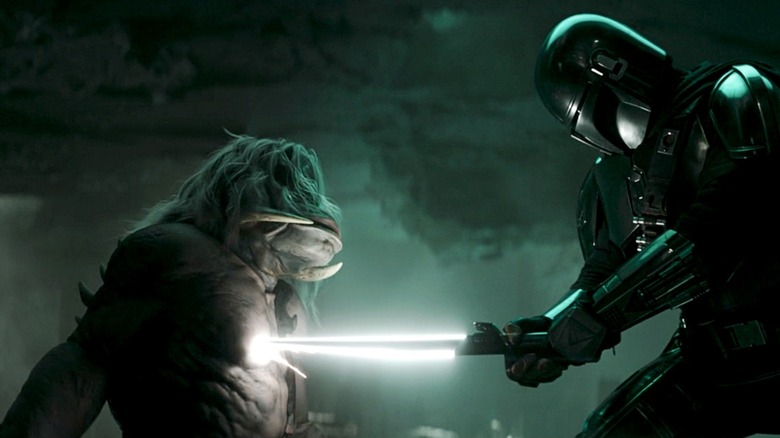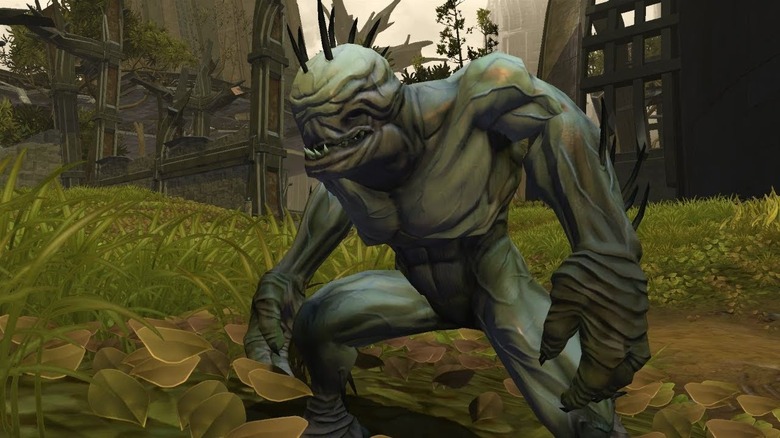The Mandalorian Brought Back A Creepy Aspect Of Star Wars Game Lore
Warning: This article contains major spoilers for the second episode of "The Mandalorian" season 3.
"The Mandalorian" is back, and season 3 is not wasting any time. Right in its second episode, "Chapter 18: The Mines of Mandalore," the show has already reached its destination, the place that has been mentioned since its first season: Mandalore. The lost home of the titular Mandalorians, Mandalore has been a significant planet in the history of the "Star Wars" galaxy for millennia. The Mandalorian civilization served an important role, going from conquerors, to peaceful people, back to conquerors, and everything in between, before becoming Pacific Islander-inspired navigators and bounty hunters.
Episode 2 finally showed us the surface of the once-splendid Mandalorian homeworld. Din Djarin, unsurprisingly, finds not a beautiful landscape of green and natural beauty, but a desolate wasteland right out of a Phil Tippett nightmare, with terrifying cyborgs that look like the child of General Grievous and the Rahkshi from "Bionicle."
Yet, despite all the horrors and dangers to be found in Mandalore, the most curious element is also the most (relatively) harmless: the Alamites. Former wasteland dwellers that now live like kings in the ruins of Mandalorian cities, these feral creatures look like something straight out of H. G. Wells' "The Time Machine. More importantly, they bear an interesting resemblance to a key aspect of the "Star Wars" video games.
Ancient threats
When we first see the Alamites, they appears to be cave-dwelling mutants like the Morlocks. According to Bo-Katan Kryze, they used to live on the desolated outskirts of Mandalore's cities. However, now that the entire planet is in ruins, they are free to roam around and be their own primitive and violent selves.
What's interesting is that this may be the first time we've seen a race of primitive cave people in "Star Wars." Sure, we've seen all kinds of civilizations and societies in the franchise before, but humanoid civilizations that are simply hidden or just beyond "civilized" society may be a first. At the same time, they are also part of a long tradition in the games, particularly those set in the Old Republic era.
Both "Knights of the Old Republic" and its spiritual successor "The Old Republic" take place in massive worlds, with different locations full of different kinds of enemies. Some are legendary Sith warriors, or Mandalorian warriors, but quite a lot of them are honestly just cannon fodder the player can use to level up quickly or practice new skills on. In the first "Knights of the Old Republic," for example, you encounter Rakghouls and other remnants of the Rakatan Empire, whereas "The Old Republic" introduced Flesh Raiders.
All of these are essentially devolved barbarians with primitive weapons that exist in large numbers and are highly ferocious. The Rakatans, once a mighty empire that spanned the whole galaxy, had lost their connection to the Force and their tech millennia before the game, turning to barbarism and even cannibalism. Then you have Flesh Raiders and Rakghouls, two mutant species bred through the dark side of the Force to serve as a military power — or a ravaging zombie plague.
Out of sight, but not out of mind
More than just being an easy, consistent, and abundant way for players to practice their killing skills, the existence of the Rakghouls and other mutant creatures make the world of "Star Wars" richer.
How so? Because the franchise tends to focus on big, bombastic villains. We have Sith Lords like Palpatine (who puppeteers an entire galaxy for his nefarious purposes), Sith warriors like Maul (who are above the fighting skill of the vast majority of people in the galaxy), or even bounty hunters like Cad Bane. Then we get beasts and other creatures like the Krayt Dragon, which are hard to kill and not that abundant. The Rakghouls, Flesh Raiders, and Alamites are a good middle-point between the Empire's faceless army Imperial Stormtroopers and the franchise's more powerful, boss-like antagonists.
Indeed, creatures like the Alamites are the closest "Star Wars" comes to actual horror movie territory, zombie films, body snatching stories, or cave-dwelling cannibal horror like "The Descent." Moreover, by showing they exist in larger numbers, this episode of "The Mandalorian" illustrates there are always horrors hiding just beneath the surface of things.
New episodes of "The Mandalorian" season 3 premiere Wednesdays on Disney+.


